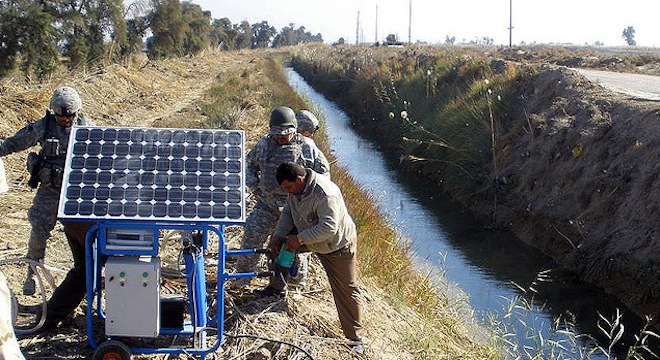TINA CASEY
If House Republicans expected the Solyndra investigation to focus public attention on their opposition to President Obama’s energy policies, by any measure they have succeeded. However, in gunning after the Department of Energy and its solar power loan program they have fallen prey to the law of unintended consequences, and are now heading on a collision course with the Department of Defense.
That is a rather odd position for the Republican Party to be in, given that it has built its brand on unequivocal support for the U.S. military, but for several years now DoD has been committed to transitioning out of petroleum fuels and into solar energy and other alternatives.
DoD highlighted its alternative energy priorities this fall with a flurry of public activity, coincidentally or not just as the Solyndra investigation was gathering steam. On September 15 the Army stood up its new Energy Initiatives Task Force with the mission of fast-tracking utility scale solar power and other renewable energy installations at its bases, and on September 13 the Air Force hosted a media roundtable on sustainable energy, following up on a public display of high performance jet biofuel by the Navy’s Blue Angels aerial demonstration team over Labor Day weekend.
The Navy also held its annual Naval Energy Forum in October under the theme “Creating Spartan Energy Warriors.” In a speech at the event on October 13 Navy Secretary Ray Mabus forcefully articulated the military reasoning behind the move away from petroleum, both foreign and domestic:
We buy too much fuel from potentially or actually volatile places on earth, those places we would never let build our ships, our aircraft, our ground vehicles, but we give them a say. We gave them a say on whether our ships sail, whether our aircraft fly, whether those ground vehicles operate because we get our fuel from them.
And even if we could get all the fossil fuels from the United States, from inside our borders, it’s still a global commodity and subject to price shocks and supply shocks and the price shocks we deal with virtually every day.
Mabus’s remarks were underscored on November 11 when the solar company SunPower Corp. announced that it was moving forward with construction of a utility-scale solar installation for the Navy at Naval Air Weapons Station China Lake in California – and that brings us right back around to the Solyndra investigation.
Practically on the same day that Mabus gave his speech, SunPower Corp. was targeted as “Solyndra 2.0” by conservative media, though for another, separate project called the California Valley Solar Ranch. That effort is a partnership with energy giant NRG, funded with a $1.2 billion loan guarantee from DOE, more than double the amount received by Solyndra.
The “worse-than-Solyndra” meme was picked up and amplified by a number of bloggers and other media. That dovetailed with comments by Republican leaders such as Rep. Darryl Issa (R-California), who in September stated that in light of competition from China it would be “reasonable to predict that we could have the collapse of the entire solar panel manufacturing business in America.”
If that is truly the case, then based on decades-long U.S. energy policy there is all the more reason to boost public subsidies for the domestic solar industry. After all, DoD’s reliance on both petroleum and nuclear energy has been supported all along by heavy taxpayer subsidies for those industries, specifically with national defense in mind.
In any case, the Solyndra investigation has failed to uncover anything out of the ordinary, and as amply documented by Media Matters, efforts to paint SunPower as another destined-to-fail solar company have fizzled, though the conservative site Human Events is still doggedly pursuing the matter through the Freedom of Information Act.
As things stand now, House Republicans are still looking for another solar energy bogeyman – and military strategists are probably wondering just who is on their side.






